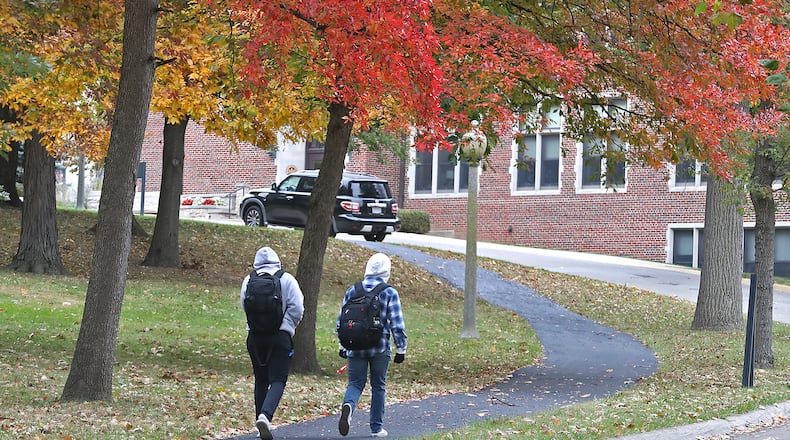“Many pandemic impacts will take years to work their way through the system, continuing to alter learners’ educational trajectories and institutions’ enrollment pipelines long after the pandemic ends,” said Doug Shapiro, executive director, National Student Clearinghouse Research Center. “Today’s missing transfer students will too often become tomorrow’s missing graduates unless educators and policy makers respond quickly with interventions tailored to the needs of affected learners.”
Both Wittenberg University and Clark State College had decreases in transfer students throughout COVID-19.
Although transfer enrollment has been on the decline, Clark State officials said institutions that already developed online transfer pathways by the start of the pandemic had a head start on recruiting.
“Students were comfortable in the online environment by the end of the pandemic. Continuing with the flexibility they had during the pandemic was a benefit,” said Travis Binkley, dead of enrollment services.
Credit: Bill Lackey
Credit: Bill Lackey
Clark State is seeing more partner colleges wanting to create transfer pathways for their technical degree students, which Binkley said is a huge benefit for the community and students.
To help with transfer enrollment, Clark State partnered with Franklin University during the pandemic to create a transfer portal where students can identify themselves through the Clark State portal as intending to transfer to Franklin for free. This waives their application fee and begins the process of transferring credits and showing what they need to complete their bachelor’s degree.
“This is just one of our awesome partnerships created during the pandemic to increase transfer and make it an easier process for students,” Binkley said.
Wittenberg officials said transfer pathways are also going to become “increasingly more important” for institutions to develop and maintain.
“No longer can an articulation agreement be signed and remain sitting in a binder with an expectation that students will flow easily into the transfer pathway - active engagement between the two institutions is critical for being able to support transfer students in their success,” said Maribeth Stevens, Witt’s vice president for enrollment management.
Stevens said students not only found themselves in a challenging predicament with the pandemic but transferring institutions already could be a difficult process.
“This was especially so during the pandemic where institutional COVID policies were constantly changing and in-person support services were often limited,” she said. “Students who would have typically begun their college coursework at a community college were instead joining the workforce to support themselves and their families financially, ultimately leading to a decrease in the number of available transfer students to four-year institutions.”
Before the pandemic in 2019-20, nearly 2.2 million students transferred to another institution to continue their college careers. During the first year of the pandemic in 2020-21, the loss of transfer students was nearly 200,000 fewer students, or -9.1%, and in the second year of the pandemic in 2021-22, it was an additional loss of -97,200 transfer students, or -4.9%, according to the Clearinghouse.
Wittenberg saw a decline of nearly 40 transfer students from 2019-22, according to the university’s institutional research division. There were 104 transfer students in 2019, 107 in 2022, 78 in 2021, and 63 in 2022.
Clark State officials saw a decline of 65 transfer students between 2020-22.
The Clearinghouse data showed nationally that transfer enrollment fell two times more steeply than non-transfer enrollment at -590,600 students or -6.3%. In 2019-20, non-transfer student enrollment declined by -193,400 or -2.1%, and by -397,200 students or -4.3% in 2021-22.
Clark State saw a continuous decline in non-transfer students from 2020-22, with 835 total. In 2019-20, there were 6,991 non-transfer students compared to 6,679 in 2021-21 and 6,156 in 2021-22.
Transfer enrollment declined the most among white students at -163,100 or -16.4%, Black students at -54,800 or -16,4%, and Native American students at -3,100 or -15.6%. These enrollment declines were steeper during the first year of the pandemic compared to the second year, according to the Clearinghouse data.
These ethnic group declines also affected those at both Wittenberg and Clark State as well.
Wittenberg’s transfer enrollment declined the most among white students at 78 in 2019 compared to 46 in 2022.That number was even less for Black students at 8 in 2019 compared to 6 in 2022. Among Hispanic students, it was 5 in 2019 and 2 in 2022.
Transfer enrollment at Clark State also declined the most among white students at 806 in 2020 versus 762 in 2022. Among Black students, enrollment declined from 269 in 2020 to 252 in 2022. Hispanic student enrollment did the same with 14 in 2020 and 46 in 2022.
“Following widespread availability of COVID-19 vaccines in early 2021, many institutions hoped there would be a return to pre-pandemic normalcy in pandemic year 2 (2021-22). Instead, the pandemic continued to impact transfer pathways, in some cases, at accelerated rates,” the report stated. “The resurgence of COVID-19 through its variants and sub-variants reminds us that higher education is not immune to the lingering effects of the pandemic.”
About the Author


